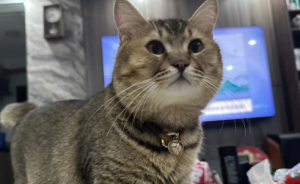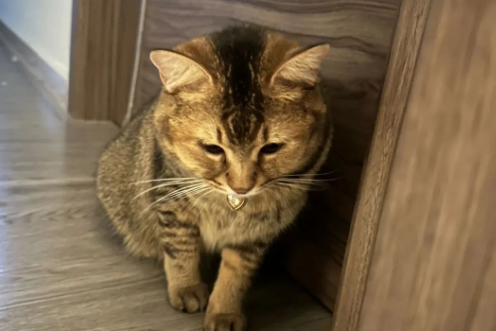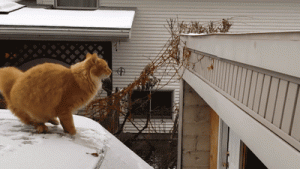I don’t know if anyone else has had the same confusion as me, but why does my little furball often hide in corners, crouch by the door, or nestle on the armrests of the couch, waiting for me to walk by? Then, out of nowhere, it suddenly leaps out and strikes a “predator” pose (of course, it’s not really an ambush—its paws are tucked away, and it’s just pretending). Hmm, so here’s the question—does my cat have some issues with its “litter box manager” at home?Well, the truth is, when cats pretend to ambush their owners, it’s one of their cute and common behaviors! There are several important reasons behind this, mostly rooted in their instincts, playful nature, and the bond they share with their owners.
-
Hunting Instinct Practice and Expression
① Cats are born hunters. Even though domesticated cats no longer need to hunt for food, the hunting instinct remains deeply ingrained in their genes.
② Ambushing is one of the core hunting techniques of felines: stalk, observe, wait for the right moment, and then pounce swiftly.
③ When cats hide in corners, behind doors, or under the sofa, and suddenly leap at their owner’s ankles, legs, or pretend to pounce on their hands, they are practicing their hunting sequence. This is an instinctual, uncontrollable impulse that needs to be released and practiced through play. -
Play and Entertainment
① For house cats, hunting is more of a game. Ambushing their owners is a way for them to entertain themselves and also a signal that they want to interact and play with their owners.
② The movement of the owner (especially their feet while walking) is seen by the cat as a “large prey” moving, triggering their instincts to chase and pounce.
③ This “pretend attack” game is very stimulating for cats, providing them with great fun and satisfaction. -
Interaction and Socializing with the Owner
① Cats see their owners as safe playmates. They know their owner isn’t real prey and won’t hurt them (which is why they usually sheathe their claws or lightly tap).
② Sometimes, this ambushing behavior is an invitation from the cat to play with its owner. After pouncing, the cat might expect the owner to respond, whether by chasing them, using toys to interact, or simply reacting with a surprised sound.
③ This is also a way for the cat to build a bond. In a cat’s social world, chasing and playful roughhousing are common behaviors among kittens and close-knit cats. Cats may extend this behavior to their relationship with their owners. -
Seeking Attention
If the owner reacts every time they’re ambushed (like screaming, jumping, chasing the cat, or petting it), the cat learns that this behavior effectively grabs their owner’s attention. Even if the owner’s reaction is “negative” (such as being startled), it’s still better than being ignored. So, they may repeat the behavior to get attention.

-
Practicing Survival Skills (Especially for Kittens)
For kittens, ambushing is especially important. They need to play (including ambushing each other or moving objects/people) to learn and hone essential survival skills like hunting techniques, physical coordination, reaction speed, and judgment.
-
In Summary
Cats pretending to ambush their owners is primarily driven by their hunting instinct and play needs. They are not attacking maliciously; instead, they are:
① Practicing hunting skills that are encoded in their genes.
② Treating the owner’s movement as an interesting target in a self-directed game.
③ Viewing their owner as a safe, reliable playmate, inviting interaction. It’s a way of seeking attention and engagement.
④ (For kittens) Practicing survival skills. -
How to Respond?
① Understand that this is normal behavior: Don’t punish your cat for this, as it will confuse or even scare them.
② Use toys as substitutes: When your cat shows ambushing tendencies, guide them to pounce on toys like a feather wand, cat stick, or small ball, instead of your hands or feet. This will help satisfy their hunting and play needs.
③ Provide plenty of playtime: Schedule a few high-quality, interactive play sessions each day (using toys to mimic prey). This will burn off their energy and reduce the chances of them venting their boredom on your feet.
④ Ignore or calmly walk away: If the cat ambushes you and you don’t want to interact, try to stay calm without reacting dramatically (screaming or running away might be seen as part of the game), and then calmly leave the area. Don’t give them the attention they’re seeking.
⑤ Offer an enriching environment: Cat trees, windowsills, boxes, etc., can give them spaces to observe, climb, and hide, satisfying their need to explore and find “ambush spots.”
So, the next time your cat suddenly “ambushes” you from a corner, understand that it’s simply using its most instinctive and joyful way to interact and play with you. It’s a sign that it considers you a close companion (even if its method is a bit unusual). I hope everyone can approach their cat’s quirky behaviors with love and understanding because, after all, they are just so incredibly cute and lovable.





